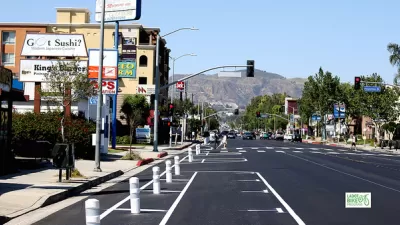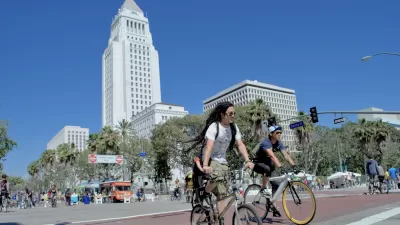Mobility Plan 2035, a visionary plan to get Angelenos out of their cars, attracted the attention of The New York Times. The plan calls for using road diets and transit-only lanes to replace auto trips with bike and bus trips, but many are skeptical.
Rather than calling the 200-page Mobility Plan 2035 a "new and controversial exercise in behavior modification," as the Los Angeles Times did in our initial post on the 20-year city planning document, Ian Lovett of The New York Times describes it as "a far-reaching transportation plan that would reshape the streetscape over the next 20 years, adding hundreds of miles of bicycle lanes, bus-only lanes and pedestrian safety features as part of an effort to nudge drivers out from behind the wheel."
Not surprisingly, in the unofficial traffic congestion capital of the country, the plan has set off fears of apocalyptic gridlock.
“What they’re trying to do is make congestion so bad, you’ll have to get out of your car,” said James O’Sullivan, a founder of Fix the City, a group that is planning a lawsuit to stop the plan.
O'Sullivan's group also threatened to sue "the Academy of Motion Picture Arts and Sciences’ $300 million movie museum on the Los Angeles County Museum of Art’s campus" over traffic, digital signage and insufficient parking spaces, reported the Larchmont Ledger in June, but that didn't stop the City Council from unanimously approving it.
However, Sarah Goodyear of CityLab writes that "(i)n 2012, Fix the City was part of a successful lawsuit that blocked a Hollywood rezoning plan that would have allowed for denser development on transit corridors."
Mobility Plan 2035 fits into an agenda that goes beyond alternative transportation. "Mayor Garcetti has encouraged residents to instead stay local and shop at nearby businesses," writes Lovett.
“The old model of a car-centric, different-neighborhood-for-every-task city is in many ways slipping through our fingers whether we like it or not,” Mr. Garcetti said. “We have to have neighborhoods that are more self-contained. People want to be able to walk or bike or take transit to a movie.”
I recall being told by a resident of Manhattan that this model is practiced in Manhattan—everything residents need can often be found in a small, walkable area around their homes. Of course, Los Angeles is not New York. Without a greater mix of uses, Garcetti's vision may not be realized. And Lovett is quick to remind the reader that in Los Angeles:
...the car reigns: Nearly 80 percent of Los Angeles commuters get to work by car, with most of the rest on buses and only 1 percent on bikes.
Indeed, the absence of Los Angeles in a list of cities with the lowest auto commuting in the latest American Community Survey was noticed by Eric Jaffe in CityLab last month: "Conspicuously absent from the list are the likes of Los Angeles and Houston. Whether their renewed efforts to reduce their car reliance and expand their bus and rail systems will result in decreased solo commute shares will be something to watch in the coming years."
However, the outcome on public safety seems promising, particularly with the mayor's signing of a Vision Zero directive last month.
“Even if more people don’t commute by bike or on a bus, if it reduces pedestrian and bike fatalities, I’d call it a win,” said Lisa Schweitzer, a professor at the Sol Price School of Public Policy at the University of Southern California (USC).
Many changes to the streetscape are already taking place. Mr. Garcetti was recently in East Los Angeles, signing a directive that laid out a goal of cutting traffic deaths to zero in 10 years. Traffic signals had been added to the street behind him, curbs had been widened, and tighter enforcement of speed limits was promised all over the city.
Mobility Plan 2035 should not be confused with the new Sustainable City pLAn, which aims to "reduce greenhouse gas emissions below the 1990 baseline by at least 45 percent by 2025, 60 percent by 2035, and 80 percent by 2050."
FULL STORY: A Los Angeles Plan to Reshape the Streetscape Sets Off Fears of Gridlock

Study: Maui’s Plan to Convert Vacation Rentals to Long-Term Housing Could Cause Nearly $1 Billion Economic Loss
The plan would reduce visitor accommodation by 25,% resulting in 1,900 jobs lost.

Alabama: Trump Terminates Settlements for Black Communities Harmed By Raw Sewage
Trump deemed the landmark civil rights agreement “illegal DEI and environmental justice policy.”

North Texas Transit Leaders Tout Benefits of TOD for Growing Region
At a summit focused on transit-oriented development, policymakers discussed how North Texas’ expanded light rail system can serve as a tool for economic growth.

San Diego County Sees a Rise in Urban Coyotes
San Diego County experiences a rise in urban coyotes, as sightings become prevalent throughout its urban neighbourhoods and surrounding areas.

Los Angeles County Invests in Wildfire Recovery for Parks, Trails, and Open Space
The $4.25 million RESTORE Program supports the recovery of parks, trails, and open spaces damaged by the January 2025 wildfires through targeted grants that promote community healing, wildfire resilience, and equitable access to nature.

Nevada Bills Aim to Establish Home Insurance Assurance Amidst Wildfire Risk
Republican sponsor hopes the FAIR plan would be “a true market of last resort.”
Urban Design for Planners 1: Software Tools
This six-course series explores essential urban design concepts using open source software and equips planners with the tools they need to participate fully in the urban design process.
Planning for Universal Design
Learn the tools for implementing Universal Design in planning regulations.
Smith Gee Studio
Alamo Area Metropolitan Planning Organization
City of Santa Clarita
Institute for Housing and Urban Development Studies (IHS)
City of Grandview
Harvard GSD Executive Education
Toledo-Lucas County Plan Commissions
Salt Lake City
NYU Wagner Graduate School of Public Service





























